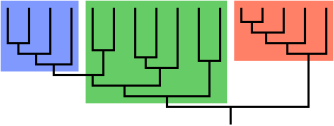
Back Grau evolutiu Catalan Evolutionary grade English Grado (cladística) Spanish Grade évolutif French Grade (biologie) Dutch Grade NB Grad ewolucyjny Polish Grado (cladística) Portuguese Града Russian Града (систематика) Ukrainian

An evolutionary grade is a group of species at the same level of organisation.[1][2]
It refers to a group of animals or plants which are very similar, but which are not a clade. They have a similar morphological or physiological complexity, and they are often adapted to the same way of life.
The term was coined by Julian Huxley, to contrast with clade, which is a strictly phylogenetic unit.[3][4] The use of 'grade' as a term in biology was strongly supported by Ernst Mayr,[5] who also pointed out that the term had been used for some time before cladism.[6]
- ↑ Futuyma D.J. 1986. Evolutionary biology. 2nd ed, Sinauer. p288
- ↑ Futuyma D.J. 2005. Evolution. Sinauer. p84 and figure 4.17
- ↑ Huxley J.S. 1958. Evolutionary processes and taxonomy with special reference to grades. Uppsala Univ. Arsskr. (1958) 21–39
- ↑ Huxley J. 1959. Clades and grades. In Cain A.J. (ed) Function and taxonomic importance. Systematics Association, London.
- ↑ Mayr, Ernst 1982. The growth of biological thought. Harvard. p614
- ↑ Bather F.A. 1927. Biological classification: past and present. Proc. Geol. Soc. 83, 62–104
© MMXXIII Rich X Search. We shall prevail. All rights reserved. Rich X Search